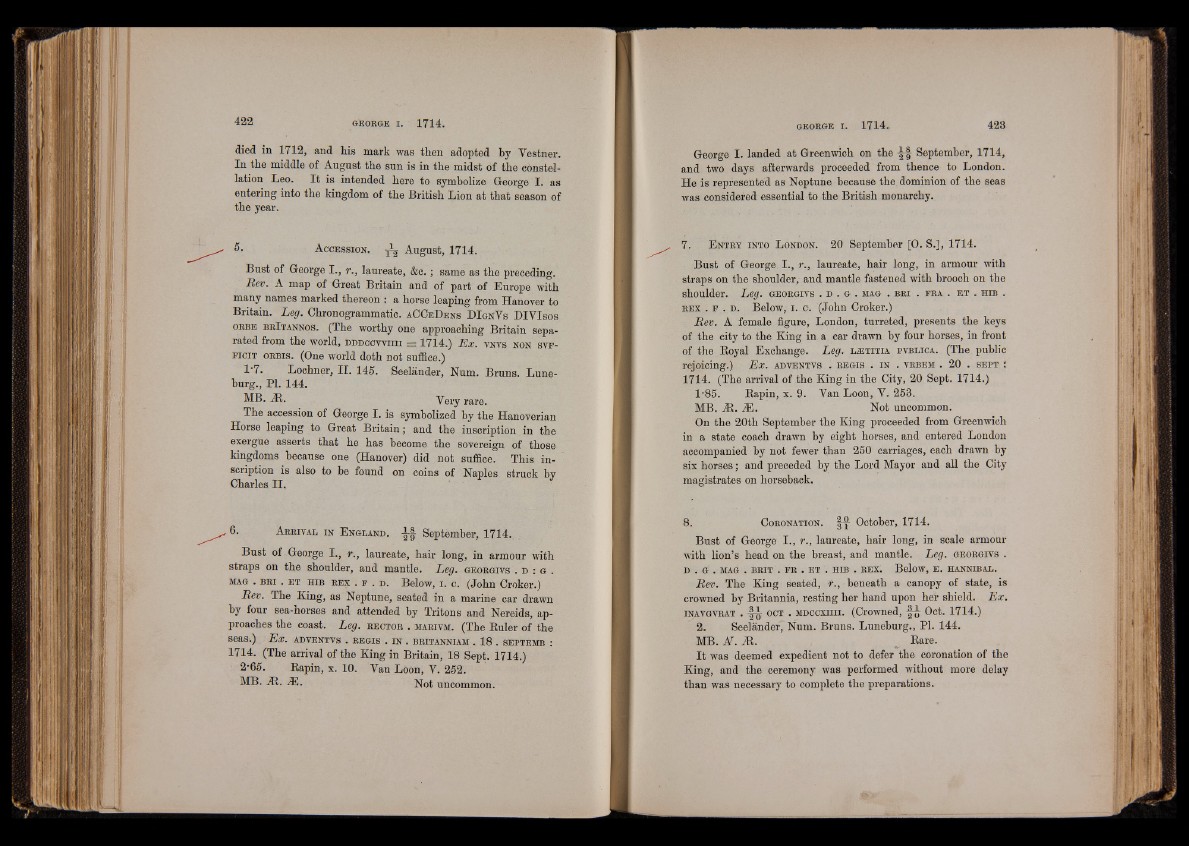
died in 1712, and his mark was then adopted by Yestner.
In the middle of August the sun is in the midst of the constellation
Leo. It is intended here to symbolize George I. as
entering into the kingdom of the British Lion at that season of
the year.
5 - A c c e s s i o n . ^ August, 1714.
Bust of George I., r., laureate, &c.; same as the preceding.
Rev. A map of Great Britain and of part of Europe with
many names marked thereon : a horse leaping from Hanover to
Britain. Leg. Chronogrammatic. aC C e D e n s D I gNVs D I V I sos
o r b e b r I ta n n o s . (The worthy one approaching Britain separated
from the world, d d d c c v v iii i — 1714.) Ex. vnys non sv f -
f ic i t o r b is . (One world doth not suffice.)
1'7. Lochner, II. 145. Seelander, Num. Bruns. Lune-
burg., PI. 144.
MB. At. Very rare.
The accession of George I. is symbolized by the Hanoverian
Horse leaping to Great Britain; and the inscription in the
exergue asserts that he has become the sovereign of those
kingdoms because one (Hanover) did not suffice. This inscription
is also to be found on coins of Naples struck by
Charles II,
6. A r r iv a l in E n g la n d . September, 1714.
Bust of George I., r., laureate, hair long, in armour with
straps on the shoulder, and mantle. Leg. g e o r g iy s . d : g .
mag . b r i . e t h ib r e x . e . d . Below, i . c . (John Croker.)
Rev. The King, as Neptune, seated in a marine car drawn
by four sea-horses and attended by Tritons and Nereids, approaches
the coast. Leg. r e c t o r . mar ivm . (The Buler of the
seas.) Ex. a d v en tv s . r e g is . in . b r ita n n iam .. 18 . s e p t em b :
1714. (The arrival of the King in Britain, 18 Sept. 1714.)
2-65. Rapin, x. 10. Van Loon, V. 252.
MB. At. Ai. Not uncommon.
George I. landed at Greenwich on the September, 1714,
and two days afterwards proceeded from thence to London.
He is represented as Neptune because the dominion of the seas
was considered essential to the British monarchy.
7. E n t r y in t o L ondon. 20 September [0. S.], 1714.
Bust of George I., r., laureate, hair long, in armour with
straps on the shoulder, and mantle fastened with brooch on the
shoulder. Leg. g e o r g i v s . d . g . m a g . b r i . f r a . e t . h i b .
r e x . f . d . Below, i . c. (John Croker.)
Rev. A female figure, London, turreted, presents the keys
of the city to the King in a car drawn by four horses, in front
of the Royal Exchange. Leg. l r t i t ia pv b l ic a . (The public
rejoicing.) Ex. a d v en tv s , r e g is . in . v r b em . 20 . s e p t :
1714. (The arrival of the King in the City, 20 Sept. 1714.)
l -85. Rapin, x. 9. Van Loon, Y. 258.
MB. At. M . Not uncommon.
On the 20th September the King proceeded from Greenwich
in a state coach drawn by eight horses, and entered London
accompanied by not fewer than 250 carriages, each drawn by
six horses; and preceded by the Lord Mayor and all the City
magistrates on horseback.
8. C o r on a t io n . | y October, 1714.
Bust of George I., r., laureate, hair long, in scale armour
with lion’s head on the breast, and mantle. Leg. g eo r g iv s .
D . G . MAG . BRIT . FR . ET . HIB . REX. Below, E . HANNIBAL.
Rev. The King seated, r., beneath a canopy of state, is
crowned by Britannia, resting her hand upon her shield. Ex.
i n a v g v r a t . -§-g- OCT . MDCCXini. (Crowned, - f y Oct. 1714.)
2. Seelander, Num. Bruns. Luneburg., PI. 144.
MB. N . At. ^ Rare.
It was deemed expedient not to defer the coronation of the
King, and the ceremony was performed without more delay
than was necessary to complete the preparations.